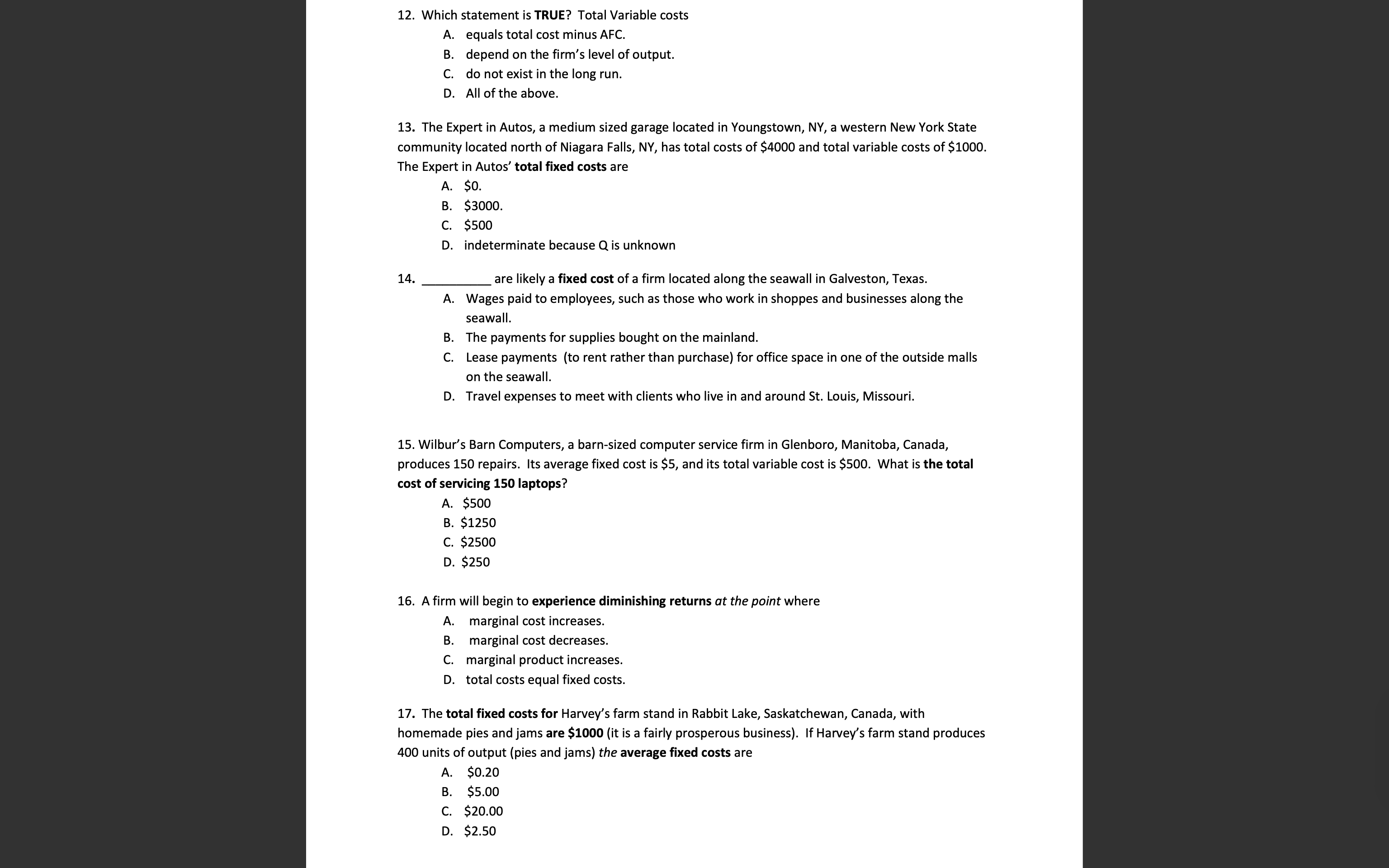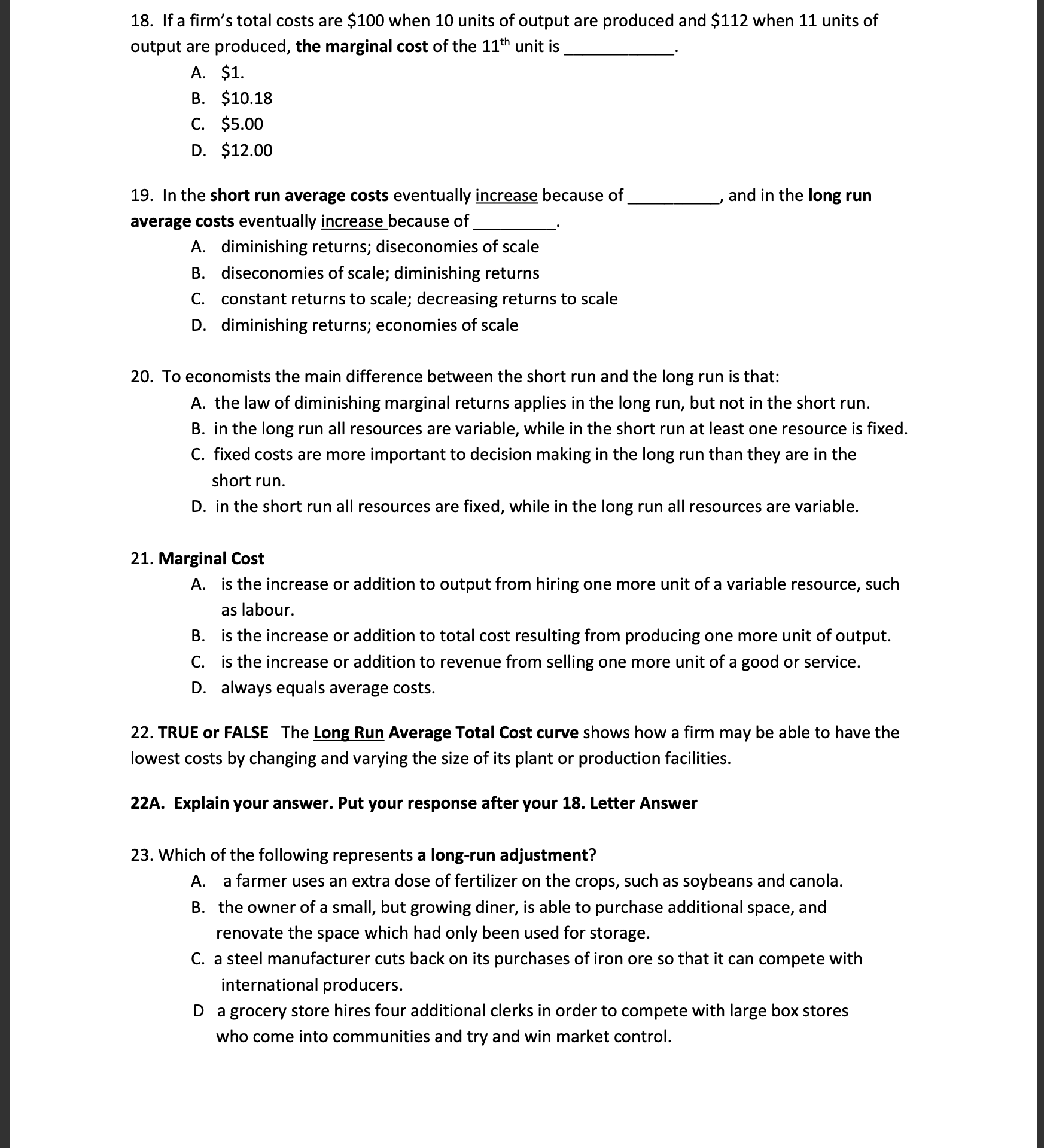no special instruction
12, which statement is TRUE? Total Variable costs A. equals total cost minus AFC, B depend on the rm's level of output. C. do not exist in the long run. D. All of the above. 13. The Expert in Autos, a medium sized garage located in Youngstown, NY, a western New York State community located north of Niagara Falls, NY, has total costs of $4000 and total variable costs of $1000. The Expert in Autos' total xed costs are A. $0. B. $3000. (2. $500 D indeterminate because Cl is unknown 14. are likely a xed cost of a rm located along the seawall in Galveston, Texas. A. Wages paid to employees, such as those who work in shoppes and businesses along the seawall. B. The payments for supplies bought on the mainland. C. Lease payments (to rent rather than purchase) for ofce space in one of the outside malls on the seawall. D. Travel expenses to meet with clients who live in and around St. Louis, Missouri. 15. Wilbul's Barn Computers, 3 barn-sized computer service rm in Glenboro, Manitoba, Canada, produces 150 repairs. lts average fixed cost is $5, and its total variable cost is $500. What is the total cost of servicing 150 laptops? A. 5500 B. $1250 C. 52500 D. $250 16, A rm will begin to experience diminishing returns at the point where A. marginal cost increases. B marginal cost decreases. C. marginal product increases, D. total costs equal fixed costs, 17. The total xed costs for Harvey's farm stand in Rabbit Lake, Saskatchewan, Canada, with homemade pies and jams are $1000 (it is a fairly prosperous business). If Harvey's farm stand produces 400 units of output (pies and jams) the average fixed costs are A. $0.20 B 55.00 C. $20.00 D. $2.50 18. If a rm's total costs are $100 when 10 units of output are produced and $112 when 11 units of output are produced, the marginal cost of the 11th unit is A. $1. B. $10.18 C. 55.00 D. $12.00 19. In the short run average costs eventually increase because of , and in the long run average costs eventually increase because of A. diminishing returns; diseconomies of scale B. diseconomies of scale; diminishing returns C. constant returns to scale; decreasing returns to scale D. diminishing returns; economies of scale 20. To economists the main difference between the short run and the long run is that: A. the law of diminishing marginal returns applies in the long run, but not in the short run. B. in the long run all resources are variable, while in the short run at least one resource is fixed. C. fixed costs are more important to decision making in the long run than they are in the short run. D. in the short run all resources are fixed, while in the long run all resources are variable. 21. Marginal Cost A. is the increase or addition to output from hiring one more unit of a variable resource, such as labour. B. is the increase or addition to total cost resulting from producing one more unit of output. C. is the increase or addition to revenue from selling one more unit of a good or service. D. always equals average costs. 22. TRUE or FALSE The Long Run Average Total Cost curve shows how a firm may be able to have the lowest costs by changing and varying the size of its plant or production facilities. 22A. Explain your answer. Put your response after your 18. Letter Answer 23. Which of the following represents a long-run adjustment? A. a farmer uses an extra dose of fertilizer on the crops, such as soybeans and canola. B. the owner of a small, but growing diner, is able to purchase additional space, and renovate the space which had only been used for storage. C. a steel manufacturer cuts back on its purchases of iron ore so that it can compete with international producers. D a grocery store hires four additional clerks in order to compete with large box stores who come into communities and try and win market control








